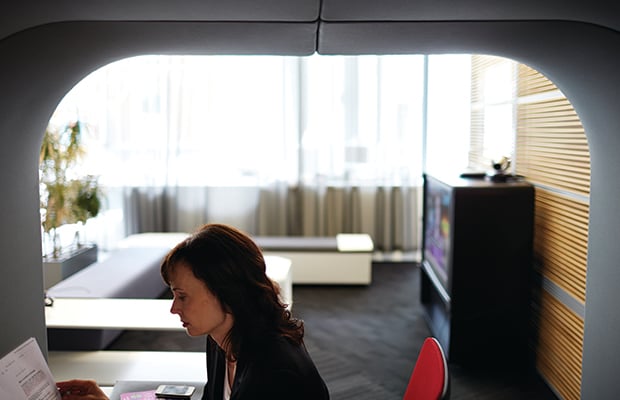Activity Based Working is an office utilization scheme implemented by many businesses today. Essentially, the model allows for multiple types of working space within one office. The setup is meant to provide different settings to support a range of corporate activities. This moves away from bordered off, personal desk spaces where workers complete all work in a single, assigned space. Instead, individuals are able to move between breakout spaces, meeting rooms, and quiet desk spaces to complete different tasks, based on what is most optimal for them.
Companies have been drawn to the concept of activity based work and applying it to their office spaces, as it has been reported as able to create flexibility, improve collaboration, and refresh a company’s internal operations as a whole. [1]
{{cta(‘b563028f-bd45-4538-8bec-9746f480b901′,’justifycenter’)}}
In efforts to implement an activity-based workplace, Condeco conducted a sensor study with global tech company, Ricoh – which greatly highlighted these benefits. Ricoh was interested in improving the organisation of their office space to increase productivity and better support creativity and cost efficiency. To provide a clear picture of the way in which employees were using the company’s space, workspace occupancy sensors were used in each meeting room and desk, gathering information on activity and usage.
 The data provided by these sensors was very telling. On average, these rooms showed to be used only 39 per cent of the time, and brought to light the reality that the larger of these rooms, suited to fit 10 people, were generally occupied by just three or less people. Additionally, these spaces were often in use by only one person for the entirety of the day. What this highlighted was the fact that private, smaller areas would be a good investment to ensure that the layout reflected the activity of employees.
The data provided by these sensors was very telling. On average, these rooms showed to be used only 39 per cent of the time, and brought to light the reality that the larger of these rooms, suited to fit 10 people, were generally occupied by just three or less people. Additionally, these spaces were often in use by only one person for the entirety of the day. What this highlighted was the fact that private, smaller areas would be a good investment to ensure that the layout reflected the activity of employees.
Another key finding revealed important steps for Ricoh to consider regarding desks. Throughout the entire study, 55 per cent of desks went completely unused. Such statistics greatly supported the need for the company to revamp office space to make the layout far better suited to employees’ working habits. This enables them to make far better use of resources and to better support their plans for future development and growth.
Overall, information from the sense study confirmed that changes had to be made for the office to be a place that truly supported the activities of workers. Going forward, moving to offices of a smaller size would be highly beneficial to Ricoh to support a more efficient and goal-oriented environment for workers. Activity-based work and how it should be applied will vary from business to business, alongside the need to adapt – as the solution is affected by factors such as location, company size, business goals, and structure. Read the full Ricoh case study here.
Sources
[1] http://www.channelpro.co.uk/opinion/9730/abw-enabling-better-collaboration-in-the-workplace